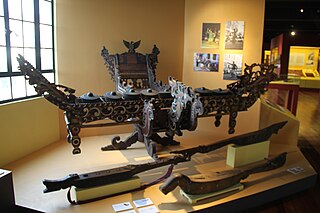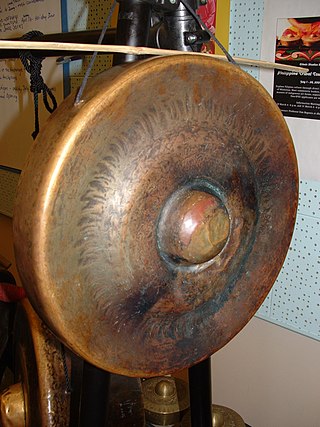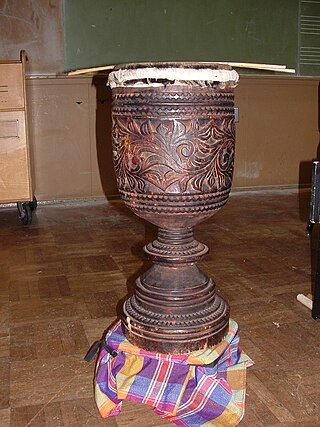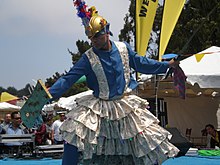
In the Old Norse written corpus, berserkers were those who were said to have fought in a trance-like fury, a characteristic which later gave rise to the modern English word berserk. Berserkers are attested to in numerous Old Norse sources.

Lanao del Sur, officially the Province of Lanao del Sur, is a province in the Philippines located in the Bangsamoro Autonomous Region in Muslim Mindanao (BARMM). The capital is the city of Marawi, and it borders Lanao del Norte to the north, Bukidnon to the east, and Maguindanao del Norte and Cotabato to the south. To the southwest lies Illana Bay, an arm of the Moro Gulf.

Kulintang is a modern term for an ancient instrumental form of music composed on a row of small, horizontally laid gongs that function melodically, accompanied by larger, suspended gongs and drums. As part of the larger gong-chime culture of Southeast Asia, kulintang music ensembles have been playing for many centuries in regions of the Southern Philippines, Eastern Malaysia, Eastern Indonesia, Brunei and Timor, Kulintang evolved from a simple native signaling tradition, and developed into its present form with the incorporation of knobbed gongs from Sundanese people in Java Island, Indonesia. Its importance stems from its association with the indigenous cultures that inhabited these islands prior to the influences of Hinduism, Buddhism, Islam, Christianity or the West, making kulintang the most developed tradition of Southeast Asian archaic gong-chime ensembles.

The Abbots Bromley Horn Dance is a folk dance which takes place each September in the village of Abbots Bromley in Staffordshire, England. It is performed by ten dancers, accompanied by a musician playing an accordion and a youth with a triangle. Six of the dancers carry reindeer horns; the remaining four are a hobby horse, Maid Marian, a fool, and a youth with a bow and arrow. On Wakes Monday, beginning early in the morning at the parish church where the horns are stored, the performers dance around the parish all day.

The kampilan is a type of single-edged sword, traditionally used by various ethnic groups in the Philippine archipelago. It has a distinct profile, with the tapered blade being much broader and thinner at the point than at its base, sometimes with a protruding spikelet along the flat side of the tip. The design of the pommel varies between ethnic groups, but it usually depicts either a buaya (crocodile), a bakunawa, a kalaw (hornbill), or a kakatua (cockatoo)..

The Maranao people, also spelled Meranao, Maranaw, and Mëranaw, is a predominantly Muslim Filipino ethnic group native to the region around Lanao Lake in the island of Mindanao. They are known for their artwork, weaving, wood, plastic and metal crafts and epic literature, the Darangen. They are ethnically and culturally closely related to the Iranun, and Maguindanaon, all three groups being denoted as speaking Danao languages and giving name to the island of Mindanao. They are grouped with other Moro people due to their shared religion.

Philippine epic poetry is the body of epic poetry in Philippine literature. Filipino epic poetry is considered to be the highest point of development for Philippine folk literature, encompassing narratives that recount the adventures of tribal heroes. These epics are transmitted through oral tradition using a select group of singers and chanters.

The Maguindanaon people are an Austronesian ethnic group from the Philippines. The Maguindanaon are part of wider political identity of Muslims known as Moro, who constitute the third largest ethnic group of Mindanao, Sulu and Palawan. The Maguindanaons constitute the ninth largest Filipino ethnic group and are known for being distinguished in the realm of visual art. They have been renowned as metalworkers, producing the wavy-bladed keris ceremonial swords and other weapons, as well as gongs. The Maguindanaons historically had an independent sultanate known as the Sultanate of Maguindanao which comprises modern day Maguindanao del Norte, Maguindanao del Sur, Zamboanga Peninsula, Davao Region and Soccsksargen. The name "Maguindanao/Magindanaw" itself was corrupted by Spanish sources into "Mindanao", which became the name for the entire island of Mindanao.

Ukrainian dance mostly refers to the traditional folk dances of the Ukrainians as an ethnic group, but may also refer to dances originating from the multiple other ethnic groups within Ukraine.

The babandil is a single, narrow-rimmed Philippine gong used primarily as the “timekeeper” of the Maguindanao kulintang ensemble.

The dabakan is a single-headed Philippine drum, primarily used as a supportive instrument in the kulintang ensemble. Among the five main kulintang instruments, it is the only non-gong element of the Maguindanao ensemble.

Tinikling is a traditional Philippine folk dance which originated prior to Spanish colonialism in the area. The dance involves at least two people beating, tapping, and sliding bamboo poles on the ground and against each other in coordination with one or more dancers who step over and in between the poles in a dance. It is traditionally danced to rondalla music, a sort of serenade played by an ensemble of stringed instruments which originated in Spain during the Middle Ages. The locomotor movements used in this dance are hopping, jumping, and turning.
The weapon dance employs weapons—or stylized versions of weapons—traditionally used in combat in order to simulate, recall, or reenact combat or the moves of combat in the form of dance, usually for some ceremonial purpose. Such dancing is quite common to folk ritual on many parts of the world. Weapon dancing is certainly ancient; among the earliest historical references we have are those that refer to the pyrrhichios, a weapon dance in ancient Sparta, in which the dance was used as a kind of ritual training for battle.

Singkil is an ethnic dance of the Philippines that has its origins in the Maranao people of Lake Lanao, a Mindanao Muslim ethnolinguistic group. The dance is widely recognized today as the royal dance of a prince and a princess weaving in and out of crisscrossed bamboo poles clapped in syncopated rhythm. While the man manipulates a sword and shield, the woman gracefully twirls a pair of fans. The dance takes its name from the belled accessory worn on the ankles of the Maranao princess. A kulintang and agung ensemble always accompanies the dance. Singkil has evolved over time, with significant reinterpretations and changes introduced by the Bayanihan folk dance group, such as the incorporation of the elements from the Darangen epic, particularly the episodes involving Prince Bantugan and Princess Gandingan.
The Arts in the Philippines are all the arts in the Philippines, from the beginning of civilization to the present. They reflect a range of artistic influences on the country's culture, including indigenous art. Philippine art consists of two branches: traditional and non-traditional art. Each branch is divided into categories and subcategories.

The Kalaság or Kalasak is a large rectangular wooden shield used by precolonial Filipinos. The shield is made of hardwood and is decorated with intricate carvings and an elaborate rattan binding on the front. The wood comes from native trees such as the dapdap, polay and sablang. The shield usually measured about 1.5 m (4.9 ft) in length and 0.5 m (1.6 ft) in width. Its base is composed of rattan wood which is strengthened by the application of resin coating that turned rock-hard upon drying.
Nyokum is a festival celebrated by the Nyishi tribe of the Indian state of Arunachal Pradesh. The Word Nyokum has been derived from the combination of two words - Nyok means land (earth) and Kum means collectiveness or togetherness. Therefore, the Nyokum festival may very well be interpreted as inviting all the Gods and Goddesses of the universe, with the Nyokum Goddess as the principal deity, to a particular venue at a particular time. The festival is commonly celebrated by the people from all class and walk of life for better productivity, prosperity and happiness of all human beings.

Darangen is a Maranao epic poem from the Lake Lanao region of Mindanao, Philippines. It consists of 17 cycles with 72,000 lines in iambic tetrameter or catalectic trochaic tetrameter. Each cycle pertains to a different self-contained story. The most notable of which deals with the exploits of the hero Bantugan.
Kancet Papatai is a traditional Indonesian war dance about a war hero and his struggle against the enemy. The dance also describes his courage and the ceremony awarding him the title Ajai, for his victory.














